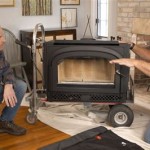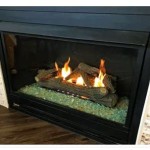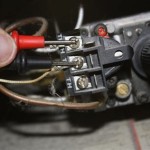Through The Wall Fireplaces: Design, Installation, and Considerations
A through the wall fireplace represents a unique category of fireplace design, distinguished by its integration directly into an existing wall. Unlike traditional fireplaces which often require extensive construction or are positioned as standalone units, through the wall fireplaces minimize spatial intrusion and offer a streamlined aesthetic. They provide a means of incorporating the ambiance and warmth of a fireplace without significantly altering the structural integrity of a room.
These fireplaces can utilize various fuel types, including gas, electric, and in some cases, wood. However, wood-burning options are less common due to the complexities involved in venting and safety regulations associated with through the wall installations. Gas and electric models are generally preferred for their ease of installation, reduced maintenance requirements, and enhanced control over heat output.
The design of a through the wall fireplace typically involves a firebox that is inserted into a framed opening within the wall. The firebox may be partially or fully recessed, depending on the desired aesthetic and the depth of the wall. The facing of the fireplace, which is the visible portion surrounding the firebox, can be customized using a wide range of materials such as stone, brick, tile, or metal, allowing for seamless integration with the existing décor of the room.
The appeal of a through the wall fireplace lies in its ability to serve as a focal point while maintaining a minimalist profile. They are particularly well-suited for modern or contemporary interior designs, where clean lines and uncluttered spaces are prioritized. Furthermore, these fireplaces can be installed in rooms where space is limited, as they do not require the same floor space as traditional fireplace units.
Key Point 1: Installation and Venting Requirements
The installation of a through the wall fireplace is a critical process that necessitates adherence to strict building codes and manufacturer specifications. Proper installation ensures the safe and efficient operation of the fireplace, preventing potential hazards such as carbon monoxide leaks or fires. It is generally recommended that installation be performed by a qualified professional with experience in fireplace installation and venting systems.
Venting is a paramount consideration for through the wall fireplaces, particularly for gas and wood-burning models. Proper venting is essential for removing combustion gases and ensuring adequate airflow to support the burning process. The venting system must be designed and installed according to local building codes and the manufacturer's recommendations. For gas fireplaces, this typically involves the use of direct vent or vent-free technology. Direct vent systems exhaust combustion gases directly to the outside through a dedicated venting pipe, while vent-free systems rely on ambient air for combustion and do not require an external vent. However, vent-free systems are subject to certain limitations and regulations regarding room size and ventilation.
Electric fireplaces, on the other hand, do not require venting as they produce heat through electrical resistance rather than combustion. This simplifies the installation process and allows for greater flexibility in placement. However, electric fireplaces do require access to a dedicated electrical circuit with sufficient amperage to handle the unit's power consumption.
In addition to venting, other installation considerations include framing the wall opening to the correct dimensions, ensuring proper insulation around the firebox, and connecting the fireplace to the appropriate fuel source (gas line or electrical circuit). It is also important to verify that the wall structure can support the weight of the fireplace unit and the facing materials used for the surround.
The complexity of installation often necessitates obtaining the relevant permits and inspections from local building authorities. This ensures that the installation meets all applicable safety standards and regulations. Failure to comply with these requirements can result in fines, delays, and potential safety hazards.
Key Point 2: Fuel Type Considerations and Efficiency
The choice of fuel type for a through the wall fireplace has a significant impact on its efficiency, cost of operation, and environmental impact. Gas, electric, and wood-burning options each offer distinct advantages and disadvantages that should be carefully considered before making a decision.
Gas fireplaces are generally considered to be more efficient than traditional wood-burning fireplaces, as they convert a higher percentage of fuel into usable heat. Gas fireplaces also offer greater control over heat output, allowing users to adjust the flame height and temperature to suit their comfort level. The convenience of gas is undeniable, with instant on/off capabilities and no need to store or handle wood.
Electric fireplaces are known for their ease of use and relatively low operating costs. They do not require any fuel source other than electricity and can be operated with or without heat, providing an aesthetic appeal even when warmth is not needed. Electric fireplaces are also highly efficient, as virtually all of the energy consumed is converted into heat. However, the heat output of electric fireplaces may be limited compared to gas or wood-burning models.
Wood-burning through the wall fireplaces are less common due to the complexities associated with venting and safety regulations. However, they offer a traditional aesthetic and the unique ambiance of a real wood fire. Wood-burning fireplaces are generally less efficient than gas or electric models, as a significant amount of heat is lost through the chimney. They also require more maintenance, including regular cleaning and chimney sweeping, and produce emissions that can contribute to air pollution. Furthermore, wood-burning fireplaces are subject to strict regulations regarding the type of wood that can be burned and the operation of the fireplace during certain air quality alerts.
Beyond the primary fuel source, fireplace efficiency can also be impacted by the unit's design and construction. Features such as sealed fireboxes, insulated walls, and advanced combustion systems can improve efficiency and reduce heat loss. It is recommended to choose a fireplace that is Energy Star certified, indicating that it meets certain minimum efficiency standards.
Key Point 3: Aesthetic Design and Customization Options
A through the wall fireplace offers substantial design flexibility, allowing homeowners to tailor the appearance of the fireplace to suit their personal style and the overall aesthetic of their home. The facing of the fireplace, which is the visible portion surrounding the firebox, can be customized using a wide range of materials and finishes.
Stone is a popular choice for fireplace facings, offering a natural and rustic look. Stone can be used in various forms, including stacked stone, fieldstone, and cultured stone. Brick is another classic option, providing a traditional and timeless aesthetic. Brick can be used in its natural red color or painted or stained to match the surrounding décor.
Tile is a versatile material that can be used to create a variety of different looks, from modern and minimalist to ornate and decorative. Tile is available in a wide range of colors, patterns, and textures, allowing for endless customization options.
Metal is a popular choice for contemporary fireplace designs, offering a sleek and modern aesthetic. Metal facings can be made from materials such as stainless steel, copper, or brass, and can be finished with a variety of different textures and patinas.
In addition to the facing material, other design elements that can be customized include the size and shape of the firebox opening, the type of firebox interior (such as brick or ceramic logs), and the presence or absence of decorative accents such as mantels or hearths. Fireplace inserts can also be used to convert existing through the wall fireplaces to a different fuel type or to improve their efficiency and aesthetic appeal.
The design of the surrounding wall area can also contribute to the overall aesthetic of the fireplace. Features such as built-in shelves, recessed lighting, or decorative paneling can be used to create a custom focal point that complements the fireplace design. It is important to consider the overall proportions and balance of the room when designing the fireplace and its surrounding area.
Homeowners should carefully consider their design preferences and the overall aesthetic of their home when choosing a through the wall fireplace and its customization options. Consulting with a professional interior designer or fireplace specialist can help to ensure that the final design is both aesthetically pleasing and functionally sound.

See Through Linear Fireplace Encino

See Through Modern Fireplaces Clear

Pin De Ef Em J E Home Inspo Casas

Pros And Cons Of Double Sided Fireplace Modus Fireplaces

Pin On New House

Boulevard See Through 60 Inch Vent Free Linear Fireplace Fine S Gas

Napoleon Clearion Linear See Through Electric Fireplace Fine S Gas

Escape See Through Gas Fireplace Dreifuss Fireplaces

See Through Linear Fireplace Encino

See Through Fireplaces Mountain West S
Related Posts








